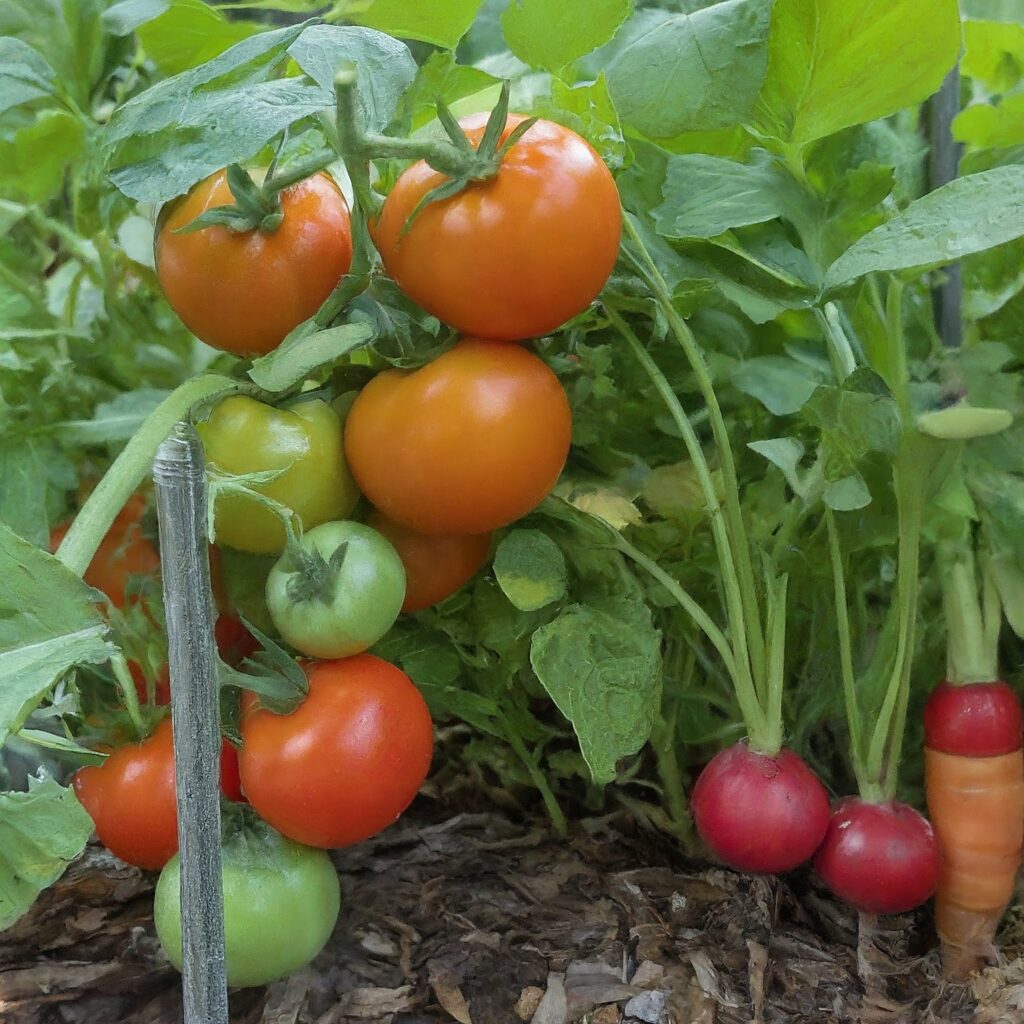Companion Plants for Tomatoes
Have you ever heard whispers about planting certain vegetables together for a better harvest? That’s the magic of companion planting! Imagine a vibrant garden scene where colorful companions not only enhance the beauty of your tomatoes but also act as a natural defense system, attracting helpful insects and deterring harmful pests.
Sounds too good to be true? Buckle up, because companion planting isn’t just folklore – it’s an experience-backed strategy with the potential to transform your tomato harvest.
Jump to a section:
Companion Planting 101: Fact or Fiction?
First things first, does companion planting really work? Well, this practice has been around for centuries. While research is ongoing, there’s evidence to suggest certain plants can benefit each other when grown in close proximity.
Here’s how companion planting with tomatoes can create a thriving garden ecosystem:
- Pest Control Powerhouse: Some plants repel or confuse unwanted insects, protecting your tomatoes from pesky critters.
- Beneficial Bug Bonanza: Certain companions attract helpful insects like ladybugs and hoverflies, who love to snack on tomato pests.
- Nutrient Neighborhood: Some plants, like legumes, fix nitrogen in the soil, enriching it for your tomatoes.
- Living Mulch Magic: Certain low-growing plants can suppress weeds and retain moisture around your tomatoes.
The Best Companion Plants for Tomatoes
Now, let’s meet the all-star cast of companion plants ready to elevate your tomato game:
Marigolds: Nature’s Nematode Fighters
These cheerful blooms aren’t just pretty faces. Marigolds release a special group of compounds called thiophenes that repel those nasty root-knot nematodes.
These microscopic worms burrow into tomato roots, disrupting nutrient and water uptake, ultimately leading to stunted growth and wilting.
As such, it is always a good idea to plant marigolds around your tomatoes for a vibrant, pest-fighting border.
Bonus points: marigolds also attract hoverflies, natural predators of aphids, adding another layer of defense to your garden.
Alliums: The Garlicky Guard
Onions, garlic, and chives belong to the Allium family, known for their pungent scents. This strong aroma, caused by sulfur-containing compounds, deters pests like aphids and spider mites.
Aphids are tiny sap-sucking insects that can weaken your tomato plants and transmit diseases. Spider mites are even tinier arachnids that create fine webs on the underside of leaves, sucking out vital fluids and causing leaves to turn yellow and drop.
When you incorporate Alliums into your planting scheme, you’re giving these harmful pests a reason to steer clear, keeping your tomato plants healthy and happy.
Peppermint: The Aromatic Armor
More than just a refreshing tea ingredient, peppermint’s sharp fragrance repels a variety of insects and even rodents. The culprit behind this powerful defense mechanism? Essential oils like menthol, which create an environment many pests find unpleasant.
While peppermint can deter beetles, flies, and even some crawling critters, it’s important to be mindful of its aggressive spreading nature. Consider using pots to keep it contained and prevent it from taking over your garden bed.
Parsley: The Beneficial Bug Beacon
This versatile herb isn’t just for garnishes! Parsley attracts hoverflies, natural predators of aphids, and its flowers attract pollinators like butterflies, creating a balanced garden ecosystem.
Hoverflies are aerial superheroes in the garden. They resemble small wasps and feed on aphids in both their adult and larval stages. By attracting hoverflies with parsley, you’re essentially introducing a natural pest control squad to patrol your tomato plants.
The best part? Parsley’s delicate white flowers provide a landing pad for pollinators like butterflies and bees, which are crucial for ensuring good fruit set on your tomatoes.
Basil: The Tomato’s BFF
This culinary classic earns its spot as one of the best companions for tomatoes. Basil’s fragrant oils are believed to repel tomato hornworms, devastating caterpillars that can devour entire tomato leaves.
While the exact science behind this is still being researched, many gardeners swear by basil’s pest-repelling properties. Plus, basil flowers are a magnet for bees, boosting pollination and ultimately leading to a more bountiful tomato harvest.
So, it makes sense to plant some basil alongside your tomatoes – it’s a delicious partnership that benefits both plants!
Bonus Buddies: Enlisting the Help of Beneficial Insects

Want to take your pest control to the next level? Here are some additional companion plants that attract beneficial insects to fight the good fight for your tomatoes:
- Carrot Family (Carrot, Celery, Dill, Fennel): These veggies attract parasitic wasps that devour tomato hornworms, acting as your own personal pest control brigade.
- Cowpeas: These legumes act as a sacrificial crop, luring stink bugs away from your precious tomatoes. Plant them at least five feet away to create a tasty distraction.
- Radishes or Pak Choi (Chinese Mustard): These fast-growing greens act as “decoy plants” for flea beetles, whose insatiable appetite for tomato leaves can be a real nuisance. Plant them directly among your tomatoes to keep the flea beetles occupied.
- Hairy Vetch: This wonder plant isn’t just a mouthful to say, it’s a champion against tomato woes. Plant hairy vetch as a cover crop in the fall. In spring, cut it down and let it decompose as mulch around your tomatoes. Hairy vetch smothers weeds, reduces diseases like blight, and even fixes nitrogen in the soil – a true triple threat! Learn how to make nitrogen fertilizer at home.
- Crimson Clover: Another superstar legume, crimson clover acts as a living mulch, suppressing weeds and offering some protection against diseases. Just remember to keep an eye on it and trim it back before it goes to seed, to prevent it from taking over your garden bed.
Plants to Avoid: Keeping Your Tomatoes Safe
While we’ve explored the amazing benefits companion plants can bring to your tomato patch, it’s equally important to be aware of plants that can hinder your tomato’s growth and health.
Here are two culprits to keep away from your precious tomatoes:
Potato Patch Peril: The Fungal Foe
Our beloved potato might seem like a natural companion for tomatoes, both being nightshade vegetables. However, this seemingly perfect pairing can turn disastrous.
Both potatoes and tomatoes are susceptible to a group of fungal diseases known as Late Blight and Early Blight. These diseases cause unsightly brown spots on leaves and stems, eventually leading to wilting and stunted growth. In severe cases, they can even wipe out your entire tomato crop.
Here’s why planting them close together is risky: fungal diseases thrive in moist environments and can easily spread from plant to plant. By keeping potatoes and tomatoes at a distance, you’re creating a barrier that makes it more difficult for the disease to jump from one plant to the other.
Planting Strategy: To minimize the risk of disease spread, plant your potatoes at least 25 feet away from your tomatoes. This distance creates a buffer zone and allows for better air circulation, which helps to discourage fungal growth.
Walnut Woes: The Juglone Threat
Walnut trees are beautiful additions to any landscape, but they can wreak havoc on your tomato plants.
The culprit behind this botanical animosity is a compound called juglone found in walnut tree roots, leaves, and even hulls of the nuts. Juglone is toxic to many plants, including tomatoes, and can cause stunted growth, wilting, and even death.
The impact of juglone can vary depending on the type of walnut tree, the soil conditions, and the distance from the tree. However, it’s generally best to avoid planting tomatoes anywhere near walnut trees.
Planting Strategy: If you have a walnut tree in your yard, unfortunately, tomatoes are not a good choice for planting directly beneath it or in the surrounding area. The safest option is to choose a different location for your tomato patch, ideally at least 50 feet away from the walnut tree’s drip line (the outermost extent of its branches).
The Final Harvest: Reap the Rewards of Companion Planting
So, the next time you plant your tomatoes, don’t go it alone! Embrace the power of companion planting and witness the magic unfold in your garden.
With a little planning and the right plant pairings, you can cultivate a flourishing tomato haven, bursting with flavor and teeming with life. Remember, companion planting is about creating a balanced and supportive environment for your tomatoes.

